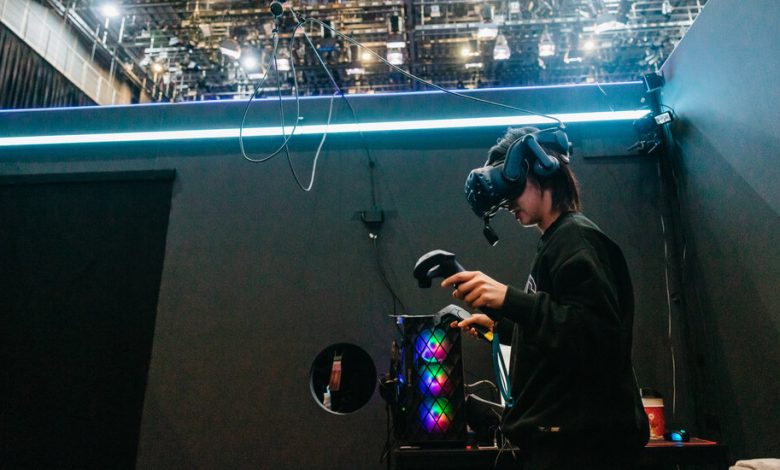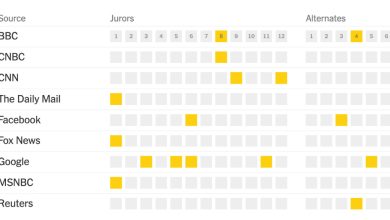Will the Metaverse Be Entertaining? Ask South Korea.

In a vast studio outside Seoul, technicians huddled in front of monitors, watching cartoon K-pop singers — at least one of whom had a tail — dance in front of a psychedelic backdrop. A woman with fairy wings fluttered by.
Everyone onscreen was real, sort of. The singers had human counterparts in the studio, isolated in cubicles, with headsets on their faces and joysticks in both hands. Immersed in a virtual world, they were competing to become part of (hopefully) the next big Korean girl band.
The stakes were high. A few of their competitors, after failing to make the cut, had been dropped into bubbling lava.
This, some say, is the future of entertainment in the metaverse, brought to you by South Korea, the world’s testing ground for all things technological.
“There are a lot of people who want to get into the metaverse, but it hasn’t reached critical mass, users-wise, yet,” said Jung Yoon-hyuk, an associate professor at Korea University’s School of Media and Communication. “Other places want to venture into the metaverse, but to be successful, you need to have good content. In Korea, that content is K-pop.”
In the metaverse — whatever that is, exactly — the normal rules don’t apply. And the Korean entertainment industry is delving into the possibilities, confident that fans will happily follow.
K-pop groups have had virtual counterparts for years. Karina, a real-life member of the band Aespa, can be seen on YouTube chatting with her digital self, “ae-Karina,” in an exchange that comes off as seamlessly as late-night TV.
The Korean company Kakao Entertainment wants to take things further. It’s working with a mobile gaming company, Netmarble, to develop a K-pop band called Mave that exists only in cyberspace, where its four artificial members will interact with real-life fans around the world.
Kakao is also behind “Girl’s Re:verse,” a K-pop-in-the-metaverse show, whose debut episode on streaming platforms this month was viewed more than a million times in three days. For both projects, Kakao is contemplating album releases, brand endorsements, video games and digital comics, among other things.
What Is the Metaverse, and Why Does It Matter?
The origins. The word “metaverse” describes a fully realized digital world that exists beyond the one in which we live. It was coined by Neal Stephenson in his 1992 novel “Snow Crash,” and the concept was further explored by Ernest Cline in his novel “Ready Player One.”
An expanding universe. The metaverse appears to have gained momentum during the online-everything shift of the pandemic. The term today refers to a variety of experiences, environments and assets that exist in the virtual space.
Some examples. Video games in which players can build their own worlds have metaverse tendencies, as does most social media. If you own a non-fungible token, virtual-reality headset or some cryptocurrency, you’re also part of the metaversal experience.
How Big Tech is shifting. Facebook staked its claim to the metaverse last year, after shipping 10 million of its virtual-reality headsets and announcing it had renamed itself Meta. Google, Microsoft and Apple have all been working on metaverse-related technology.
The future. Many people in tech believe the metaverse will herald an era in which our virtual lives will play as important a role as our physical realities. Some experts warn that it could still turn out to be a fad or even dangerous.
Compared with their Korean counterparts, media companies in the United States have only engaged in “light experimentation” with the metaverse so far, said Andrew Wallenstein, the president and chief media analyst of Variety Intelligence Platform.
Countries like South Korea “are often looked at like a test bed for how the future is going to pan out,” Mr. Wallenstein said. “If any trend is going to move from overseas to the U.S., I would put South Korea at the front of the line in terms of who is likeliest to be that springboard.”
South Korea’s experiments with virtual entertainment date back at least 25 years, to the brief life span of an artificial singer called Adam. A child of the ’90s, he was a pixelated creature of computer graphics, with sweepy eye-covering bangs and a raspy voice that tried a bit too hard to sound sexy. Adam disappeared from the public eye after releasing an album in 1998.
But digital creations like him, or it, have been a hallmark of Korean popular culture for a generation.Today, Korean “virtual influencers” like Rozy and Lucy have Instagram followings in the six figures and promote very real brands, like Chevrolet and Gucci.
The influencers have been purposely made to look almost real, but not quite; their near-human quality is part of their appeal, said Baik Seung-yup, Rozy’s creator.
“We want to create a new genre of content,” said Mr. Baik, who estimated that about 70 percent of the world’s virtual influencers are Korean.




A few of the many worlds of “W.”Credit…Kakao Entertainment
According to McKinsey, more than $120 billion was spent globally on developing metaverse technology in the first five months of 2022. Much of that came from companies operating in the United States, said Matthew Ball, a tech entrepreneur who has written a book about the metaverse.
The highest-profile recent example was when Facebook renamed itself “Meta” in a multibillion-dollar attempt to embrace the next digital frontier, only to see its stock tumble and its earnings decline.
The South Korean government is investing more than $170 million to support development efforts here, forming what it calls a “metaverse alliance” that includes hundreds of companies. Mr. Ball said it is one of the most aggressive programs of its kind. But while South Korea may be “leagues ahead” when it comes to synthetic pop stars, whether its companies are likely to take a leading role as the metaverse evolves “is an open question,” Mr. Ball said.
Government backing for new technologies has paid off for South Korea in the past. The country built its modern economy over the past few decades on the backs of tech conglomerates and placed a winning bet on the cellphone industry, laying the groundwork for it to become what Bernie Cho, a music executive in Seoul, called “the most wired and wireless country.”
Teenagers here scroll through comics on phones, consume countless hours of Korean dramas without a cable box and zealously follow K-pop stars on social media and new platforms. On Zepeto and Weverse, fans interact with each other, sometimes as customizable avatars, and with their favorite bands.
Kakao Entertainment — an arm of Kakao, South Korea’s do-everything tech company — is billing Mave, its artificial band in progress, as the first K-pop group created entirely within the metaverse, using machine learning, deep fake, face swap and full 3-D production technology. To give them global appeal, the company wants the “girls” of Mave to eventually be able to converse in, say, Portuguese with a Brazilian fan and Mandarin with someone in Taiwan, fluently and convincingly.
The idea, said Kang Sung-ku, a technical director for the project, is that once such virtual beings can simulate meaningful conversations, “no real human will ever be lonely.”
Kakao’s singing show, “Girl’s Re:verse,” has a familiar reality-TV “survival” format: 30 singers, eliminated over time, until the last five standing form a band. But the contestants — all members of established K-pop bands or solo artists — compete, banter and hang out as avatars, in a virtual world called “W.” Their real identities are not revealed until they leave the show (in some cases, by way of the lava) or make it to the end.
There are few limits to the imagination in “W,” which whisks its contestants from the open sea to a Versailles-like palace to a desert landscape. One avatar is a chocolate princess, born in a cocoa tree; another has red devil horns. Pengsoo, a blunt-talking penguin mascot popular in South Korea, is one of the judges.
The contestants were involved in creating their avatars, said Son Su-jung, a producer for the show. She said part of the point was to give K-pop singers — “idols,” as they are called — a break from the industry’s relentless beauty standards, letting them be judged by their talent, not their looks. (Though the avatars, it should perhaps be said, all have big eyes and heart-shaped faces.)
The show also lets them drop their polished public personas, relax and crack jokes. “Idols in the real world are expected to be a product of perfection, but we hope that through this show, they can let go of those pressures,” Ms. Son said.
At a recent taping, glitches were still being ironed out. Support staff popped in and out of cubicles to help singers fiddle with their equipment. At least one mishap made it into the first episode: “I can’t hear you!” a contestant yelled as a judge repeatedly asked her the same question.
But some things about reality TV hadn’t changed. Even avatars, it turns out, are encouraged to snipe at their competitors.
“Look at the green light,” a producer intoned through a microphone to a contestant, whose avatar stared back at him from the screen.
“Who do you think did the worst?” he said. “Talk as if you’re gossiping about someone.”





